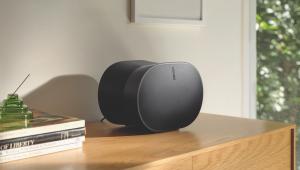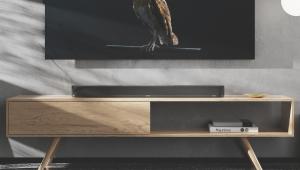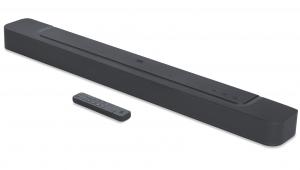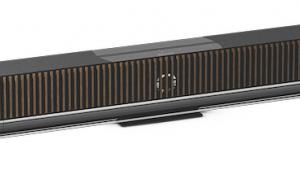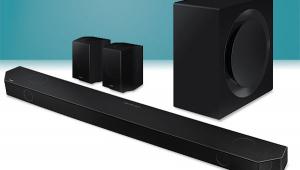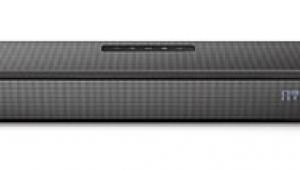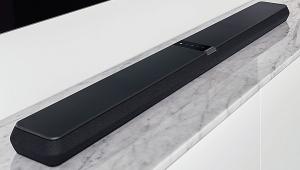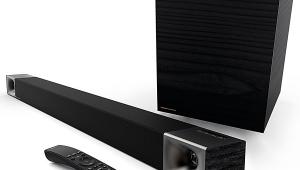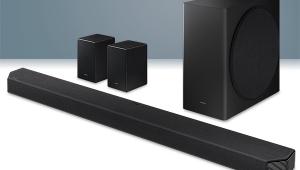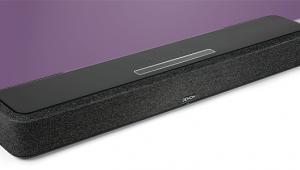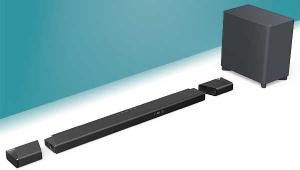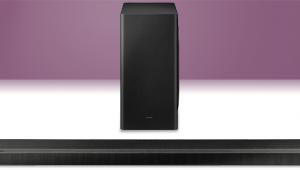Bose Solo TV Sound System review

The Bose Solo is more of a soundbox than a soundbar, having been designed by Bose to sit underneath your screen rather than in front of it. This cunning approach, where the TV stand is plonked on top of the unit, eliminates the problem of the soundbar encroaching on the screen (or the remote control receiver at the very least), which can happen with shallow stands and/or tall 'bars. From a distance the box looks like a PVR or deck, upon which one would never dream of placing a TV.
The pedestal design means that no separate subwoofer is deemed necessary, with the Solo able to accommodate four drivers (of unspecified size and power) and two rear-facing bass ports.
The Solo can manage screens with stands that fit on its surface dimensions of 508mm x 260mm. Yet the suggested weight limit of 18kg means that the Solo cannot be used as a base for many screens, especially those over 40in. It can, of course, be placed on the shelf of an AV rack, which you might find aesthetically preferable anyway, given the somewhat bland design.
On the plus side, build quality is of Bose's typically high standard, but there’s disappointment to be found on the connections front. The Solo lacks HDMI provision, which, of course, means no hi-res surround sound decoding. Instead, audio is fed via the dual coaxial audio and digital optical audio inputs, or the stereo phonos for analogue action.
My thoughts of assigning Sky+ HD to the optical input, a Blu-ray deck to the coax and a games console to the phonos were short-lived when I discovered that only one input can be physically connected at any one time. The idea here is that the Solo is strictly intended to boost your TV’s sound (using just one input). Want Bluetooth, AirPlay, USB streaming or even a mini-jack line in? Look elsewhere.
Keeping it simpleBose's operating system is far from taxing. There's no LCD display, just a single LED that glows green when on, blinks when mute, blinks faster when you adjust the volume and goes red if there’s an error. There are no selectable DSP modes, no tone control and no tools for tweaking the driver levels. Bose’s argument is that the Solo just works, all you need to do is turn it on and set the volume. Hence the credit-card style remote control sports just four buttons: power, volume up, volume down and mute. Like the main unit, build quality is reassuringly solid. Bose’s minimalist approach is arguably liberating but in the information age it can be a source of frustration.
Still, there’s no arguing about the significant step up in quality the Solo provides compared with your flatscreen’s speakers. The climatic battle scene of The Chronicles of Narnia: Prince Caspian on Blu-ray is highly engaging, with real impact across the dynamic range and no shortage of low-end welly. Band of Brothers, meanwhile, has a strong sense of refinement that allows dialogue to be delivered with clarity. The Solo lacks a bit of finesse, though: during the attack on the giant tree in Avatar it’s hard to pick out individual effects during the melée, while sword clashes in Narnia are a little clipped. Dialogue, on the other hand, is a real strength, with the voice of Mad Men’s Don Draper rich and satisfying, and musically the Solo is a strong performer – Talking Heads' Life During Wartime (Stop Making Sense, DTS-HD MA Blu-ray) is presented with lively authority and tightness.
Bose's Solo therefore presents an extraordinarily simple answer to the question of thin TV audio, with a decent sonic performance – but its setup inflexibility makes it more of a bedroom solution than a living room one.
Bose Solo TV Sound System
Price: £350
HCC Verdict: 3.5/5
 |
Home Cinema Choice #351 is on sale now, featuring: Samsung S95D flagship OLED TV; Ascendo loudspeakers; Pioneer VSA-LX805 AV receiver; UST projector roundup; 2024’s summer movies; Conan 4K; and more
|



